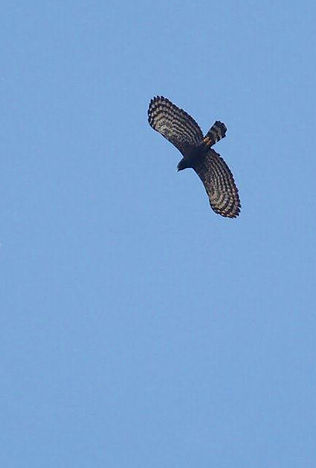
RAPTOR RESEARCH TEAM
micrastur. rupornis. harpia. morphnus. spizaetus. cathartes. glaucidium. ictinia. pulsatrix. falco.
Volunteer and Internship Opportunities
* All training provided *
Understanding the diversity, population dynamics, home range
and movement characteristics of raptors in Amazonian Peru
Team Objectives
The Raptor Research Team, with headquarters in the city of Puerto Maldonado, is tasked with monitoring the number of raptor species at each of our wildlife research sites. In addition to diversity, the team is tasked with assessing the relative abundance, density, diurnal movement pattern (and nocturnal pattern in the case of owls) and home range size of each species and how these vary within and between sites. Identifying next sites and key foraging areas are also important objectives. In combination with vegetation, land use, and climate information for each site, the team can better understand how and why raptor populations change across the Madre de Dios region of Amazonian Peru, and help in the conservation planning of this ecologically important group of birds.


Black-and-white hawk-eagle (Spizaetus melanoleucus).
Photo: Amanda Guercio
Black hawk-eagle (Spizaetus tyrannus).
Photo: Amanda Guercio
GPS tracker
for raptors


A close-up shot of the White-browed hawk (Leucopternis kuhli). Photo: Amanda Guercio
Methods Used and Skills Taught
The methods and techniques that our volunteers and interns actively learn in this team, under the leadership and supervision of our raptor research coordinator, include points counts of perched and flying raptors, call- and visual-based identification of species (including when soaring), unbounded line transects, camera traps, mist-netting with call-back and banding, baited bal-chatri traps, baited bow nets, Verbail traps, GPS tracking devices with GIS-based analysis of raptor movement data, and finally plot-based vegetation and habitat sampling. Time will also be spent caring for live bait species, such as rodents and chickens. Data analysis and visualisation programs that we use include R, SPSS, Estimates, and QGIS.
(Left) A White-browed hawk (Leucopternis kuhli) temporarily captured using a mist net.
Photo: Amanda Guercio
A Typical Day
Research periods are split into morning, afternoon, and night sessions, although typically active fieldwork is largely undertaken during two of these sessions on any particular day (e.g. afternoon and night or morning and afternoon), for a total of between 6-8 hrs per day. Morning session activities begin after breakfast at 7:00 am with caring for live bait species, followed by point counts or unbounded line transect surveys of soaring and perched raptors in open and forested areas. Mid-morning and mid-afternoon periods are also the best times for setting and monitoring the various baited traps (Bal-chatri, Verbail, bow nets) and of course, processing any captured raptors. Processing a bird once it has been extracted from a net or trap, involves placing a numbered and/or coloured band on its leg, weighing it, measuring it, assessing its sex and age from plumage and molt characteristics, and safely attaching a GPS tracking device (if it happens to be one of the focal species of interest for tracking). Night sampling sessions, focused on understanding owl ecology, begin after dinner at 8 pm and last around 3 hours. Unbounded line transect surveys of owls, using auditory cues, and nocturnal trapping of owls are the main activities, including processing captured owls in a similar manner to that described above. Vegetation and habitat sampling is undertaken across the home ranges used by focal raptor species, using multiple 10x50m vegetation plots. When weather conditions may not allow for raptor or vegetation sampling to take place, then these periods are used for data entry and data analysis purposes using project laptops. All research schedules and activities are subject to change at the discretion of the team coordinator.

A magnificent Ornate hawk eagle (Spizaetus ornatus) resting on the forest floor after having recently caught and eaten a prey item. Camera trap video: Chris Kirkby
Volunteer and Intern Participation Fees
Included
All meals (veg options available) and lodging (shared rooms), scheduled transfers, field training and supervision, research permits, research activities.
Not included
Flights, non-scheduled transfers, clothes washing, rubber boots, rain poncho, personal medical issues.
1 week - US$ 500
2 weeks - US$ 900
3 weeks - US$ 1200
1 month - US$ 1600
6 weeks - US$ 2200
2 months - US$ 2850
3 months - US$ 4100
Dates
Any time of year. We recommend successful applicants arrive in the city of Puerto Maldonado (PEM) on either a Tuesday, Wednesday, or Thursday if at all possible. The city is served by daily flights from Lima (LIM) and Cusco (CUZ) via the airline Latam.
Non-profit Fee Breakdown
Transfers 4%
Accommodation 18%
Meals 14%
Equipment 4%
Repairs 4%
Communication 18%
Staff 14%
Profit 0%
Recommended Reading
Books and Field Guides

Raptors of the World
By: James Ferguson-Lees

Birds of Peru
By: T.S. Schulenberg

Owls of the World
By: Konig & Weick
Published Articles
Meyburg (1992) Monitoring raptors by means of satellite telemetry: Some goals, achievements and limitations. World Working Group on Birds of Prey, Berlin.
Hull & Bloom (2001) The North American Banders Manual for Raptor Banding Techniques. North American Banding Council.
Thorstrom (2001) Methods for capturing tropical forest birds of prey. Wildlife Society Bulletin 1996 24(3): 516-520.
Lloyd (2003) Population densities of some nocturnal raptor species (Strigidae) in southeastern Peru. Journal of Field Ornithology 74(4): 376-380.
Taylor (2017) The Motus Wildlife Tracking System: A collaborative research network to enhance the understanding of wildlife movement. Avian Conservation and Ecology 12(1): 8. https://doi.org/10.5751/ACE-00953-120108







